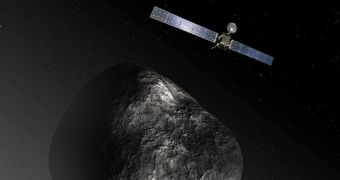This past June 30, researchers with NASA (the National Aeronautics and Space Administration in the United States) announced that a comet they had been studying for quite a while could accurately be described as a seriously oversized space sprinkler.
The comet in question is known to the scientific community as 67P/Churyumov-Gerasimenko, and evidence at hand indicates that it releases about two glasses worth of water every second, NASA explains on its website.
This means that, were somebody to take some time off work and chase after this comet for a little over three months, they might just get enough water to keep their garden green throughout the entire summer, or fill a pool.
“At this production rate, comet 67P/Churyumov-Gerasimenko would fill an Olympic-size swimming pool in about 100 days,” explained researcher Sam Gulkis with NASA's Jet Propulsion Laboratory in Pasadena, California.
Information shared with the public says that the Microwave Instrument for Rosetta Orbiter aboard the European Space Agency's Rosetta spacecraft first detected water vapors released by this comet earlier this year, on June 6.
At that time, 67P/Churyumov-Gerasimenko was located at a distance of about 261 million miles (420 million kilometers) from Earth and 354 million miles (569 million kilometers) from the Sun, NASA specialists say.
It is expected that, as the comet comes closer to said star, gas production will up. Simply put, it is very likely that 67P/Churyumov-Gerasimenko will soon be releasing significantly more water than it currently does.
“As the comet gets closer to the sun, the gas production rate will increase,” Sam Gulkis said. Furthermore, “With Rosetta, we have an amazing vantage point to observe these changes up close and learn more about exactly why they happen.”
On its website, NASA explains that this discovery is important not just for cometary science, but also when it comes to mission planning. Specifically, this information will especially come in handy later this year, when the Rosetta spacecraft officially becomes the comet's stalker.
Thus, NASA expects that, come August, said spacecraft will successfully start orbiting the comet and accompany it on its journey around the Sun. Later this year, in November, the Rosetta spacecraft is scheduled to deploy a lander on the comet's surface.
“Our comet is coming out of its deep-space slumber and beginning to put on a show for Rosetta's science instruments,” Matt Taylor with the European Space Agency's Science and Technology Centre in Noordwijk, The Netherlands, commented on the discovery of this comet's water trail.
“The mission's engineers will be using this MIRO data to help them plan for future mission events when we are operating in close proximity to the comet's nucleus,” the researcher went on to argue.

 14 DAY TRIAL //
14 DAY TRIAL //